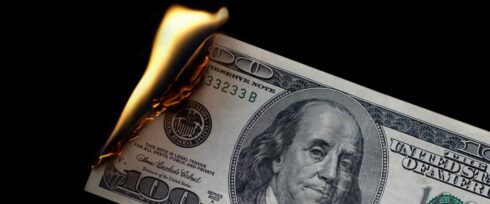Renewed American escalations in Ukraine confirms Russia’s need to de-dollarize.
Written by Paul Antonopoulos, independent geopolitical analyst
The Central Bank of Russia has again sharply reduced its investment in US government bonds. In fact, Moscow has been systematically getting rid of these securities since NATO instigated a war in Donbass in 2014 and imposed sanctions against Russia for foiling Washington’s plans in Ukraine. The latest threats of sanctions over the American-manufactured crisis in Ukraine will only accelerate Russia’s de-dollarization process.
The US Treasury Department reported that Russia cut its investment in US government securities to $2.4 billion in November 2021. In October it was $3.72 billion, and in September it was $3.91 billion. These bonds are one of the White House’s main financial instruments to help offset the budget deficit. However, Russia’s holdings of the securities have almost been completely sold. Back in 2010-2013, Russian investment in US debt exceeded $140 billion, but when Washington announced sanctions in April 2014, they started getting rid of these bonds.
In 2018, the Central Bank of Russia embarked on a massive sell-off, halving its US Treasury portfolio to $13.2 billion. Since then, the Treasury’s share of Russian gold reserves has basically not increased. Investments may increase slightly time to time, which is necessary to balance the portfolio, but in general it is gradually reduced. American bonds now account for less than a percent of international reserves. The funds spent by Russia were transferred to gold, euros and yuan.
Since October, Russia has continued to sell and dollar assets have fallen to record lows. This is part of Russia’s drive to reduce its reliance on the US dollar in the face of severe sanctions following the 2014 War in Donbass. Although data is not available for December 2021 yet, it is expected that once the data is released it will show another reduction in Russia’s investments in US government bonds.
However, the formation of reserves is not only a matter of market expediency. Currency diversification away from the US dollar increases the resilience of the Russian financial system from American pressures. By getting rid of America’s public debt, Russia reduces the effects of sanctions and geopolitical risks, something incredibly important as the Anglo Axis (USA-UK-Australia) escalates its tensions with Moscow over Ukraine. It is already clear that relations between the two countries have escalated again and Washington is threatening Moscow with new sanctions, even against President Vladimir Putin directly.
Meanwhile, while the share of US government bonds in gold reserves has become purely symbolic, this does not mean that everything needs to be sold. Treasury securities are highly liquid assets and can be converted quickly into the world’s major currencies (such as the Euro, pound or yuan) and sold at any time. It is also a convenient tool for securing liabilities, for example, transactions in other assets.
In addition, the vast majority of international payments are still made in US dollars as it serves as the globe’s main financial and commodity flow. Another thing is that Russia is deliberately moving away from systemic risk, hence why the selling of bonds is not just about geopolitics and sanctions.
The financial situation in the US itself raises questions for many investors as there is a perplexing huge and increasing debt of almost $30 trillion that is continuing to increase second-by-second. Last August, the Americans once again stood against legislation to limit public debt. This maneuver prevented the country from borrowing, but by then, Treasury bills had already exceeded the size of the US economy by $28.5 trillion. As a result, the Ministry of Finance launched a series of large government bond issues.
Lending money to Washington continues, but there are growing fears about whether the US is capable of repaying this loan. At the end of 2021, Russia’s international reserves reached an all-time high of $630.5 billion. These highly liquid foreign assets are managed by the Central Bank and the Government and are used to cover payment deficits, influence the ruble rate through intervention, pay external loans, settle transactions with other countries and to fulfil social obligations.
Gold has also dominated in recent years and become favoured by countries engaged in the de-dollarization process. At the end of June 2020, the share of precious metal surpassed the dollar for the first time – by 23% compared to 22%. About a third of the assets are euro and 12% are yuan.
By the end of 2021, the Bank of Russia increased its gold reserves to 74 million ounces. That’s about $133 billion, or 21.3% of gold reserves. Such a high rate provides additional stability, ensures reliability, diversification and value growth. Now about a third of developed countries’ reserves are stored as gold.
In this way, Russia is making every effort to offset the effects that strengthened sanctions, that the US is desperately trying to push for, would have on the economy. European partners are trying to avoid such a scenario, but they too have expressed their willingness to strengthen sanctions if Russia were to invade Ukraine, something that the Kremlin has repeatedly stressed that it has no intention of doing.







The Eu are the US toilet paper